oil temperature TOYOTA SEQUOIA 2008 2.G Owners Manual
[x] Cancel search | Manufacturer: TOYOTA, Model Year: 2008, Model line: SEQUOIA, Model: TOYOTA SEQUOIA 2008 2.GPages: 596, PDF Size: 12.93 MB
Page 157 of 596

157
2
When driving
2-2. Instrument cluster
Gauges and meters
Vehicles with multi-information display
The following gauges, meters and displays illuminate when the
engine switch is in the ON position. Tachometer
Displays the engine speed in revolutions per minute.
Speedometer
Displays the vehicle speed.
Fuel gauge
Displays the quantity of fuel remaining in the tank.
Vo l t m e t e r
Displays the charge state.
Engine oil pressure gauge
Displays the engine oil pressure.
Engine coolant temperature gauge
Displays the engine coolant temperature.
Odometer/trip meter switching and trip meter resetting button
Switches between odometer and trip meter displays. Pushing and hold-
ing the button will reset the trip meter when the trip meter is being dis-
played.
Page 159 of 596
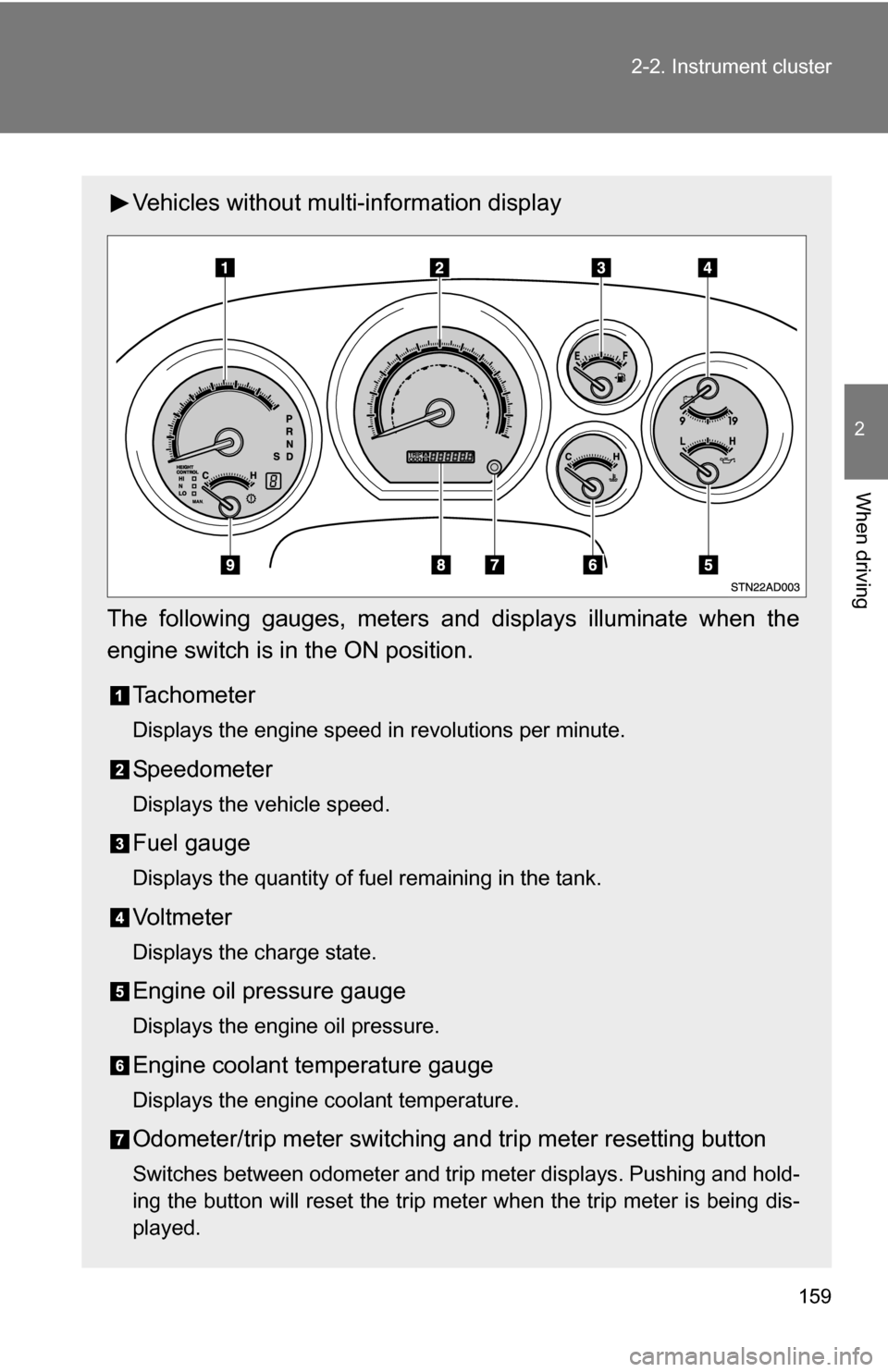
159
2-2. Instrument cluster
2
When driving
Vehicles without multi-information display
The following gauges, meters and displays illuminate when the
engine switch is in the ON position. Tachometer
Displays the engine speed in revolutions per minute.
Speedometer
Displays the vehicle speed.
Fuel gauge
Displays the quantity of fuel remaining in the tank.
Vo l t m e t e r
Displays the charge state.
Engine oil pressure gauge
Displays the engine oil pressure.
Engine coolant temperature gauge
Displays the engine coolant temperature.
Odometer/trip meter switching and trip meter resetting button
Switches between odometer and trip meter displays. Pushing and hold-
ing the button will reset the trip meter when the trip meter is being dis-
played.
Page 161 of 596
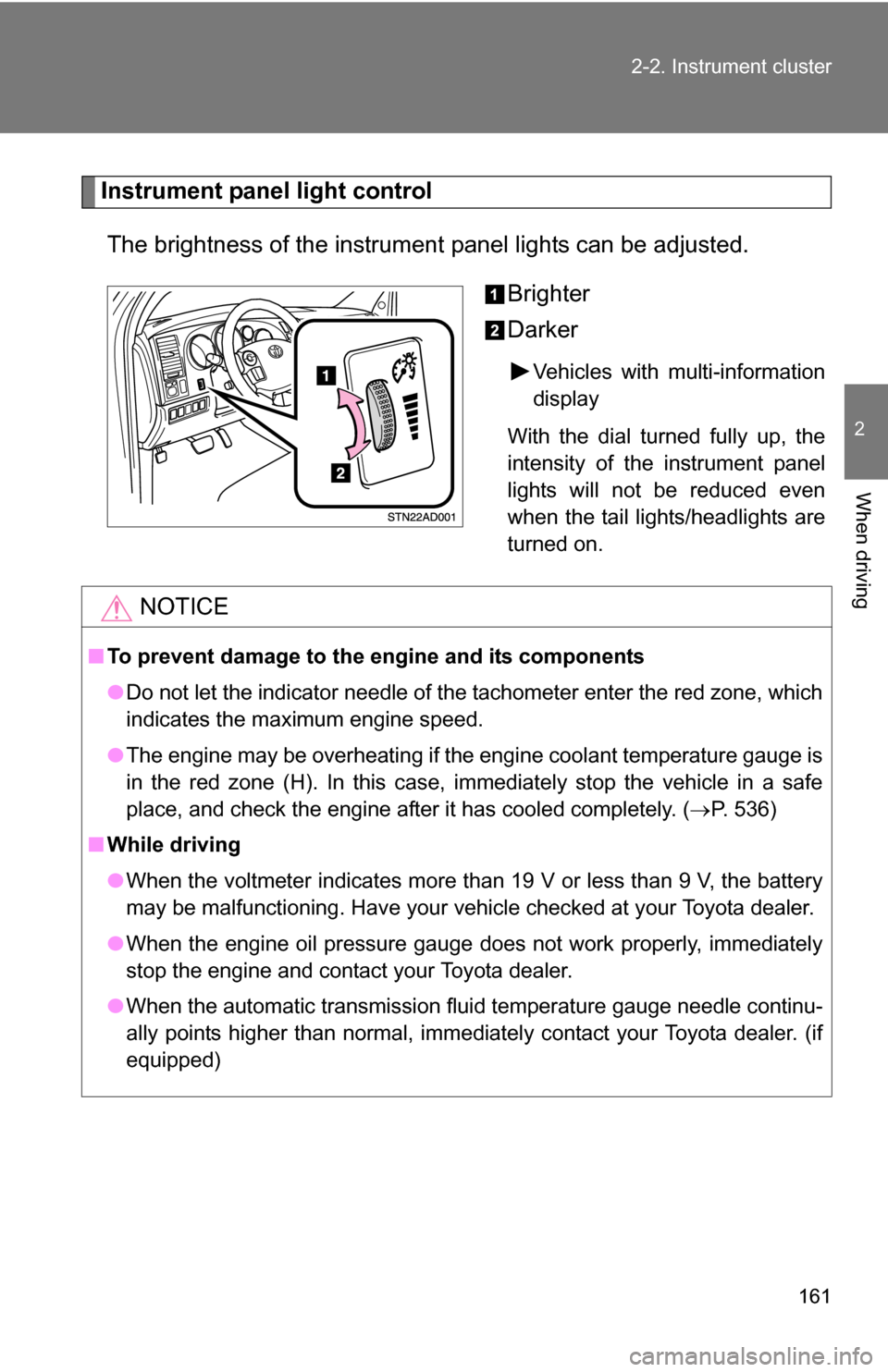
161
2-2. Instrument cluster
2
When driving
Instrument panel light control
The brightness of the instrument panel lights can be adjusted.
Brighter
Darker
Vehicles with multi-information
display
With the dial turned fully up, the
intensity of the instrument panel
lights will not be reduced even
when the tail lights/headlights are
turned on.
NOTICE
■ To prevent damage to the engine and its components
●Do not let the indicator needle of the tachometer enter the red zone, which
indicates the maximum engine speed.
● The engine may be overheating if the engine coolant temperature gauge is
in the red zone (H). In this case, immediately stop the vehicle in a safe
place, and check the engine after it has cooled completely. ( P. 536)
■ While driving
●When the voltmeter indicates more than 19 V or less than 9 V, the battery
may be malfunctioning. Have your vehicle checked at your Toyota dealer.
● When the engine oil pressure gauge does not work properly, immediately
stop the engine and contact your Toyota dealer.
● When the automatic transmission fluid temperature gauge needle continu-
ally points higher than normal, immediately contact your Toyota dealer. (if
equipped)
Page 435 of 596

435
4-3. Do-it-yourself maintenance
4
Maintenance and care
CAUTION
The engine compartment contains many mechanisms and fluids that may
move suddenly, become hot, or become electrically energized. To avoid death
or serious injury observe the following precautions.
■
When working on the engine compartment
●Keep hands, clothing, and tools away from the moving fan and engine
drive belt.
● Be careful not to touch the engine, radiator, exhaust manifold, etc. right
after driving as they may be hot. Oil and other fluids may also be hot.
● Do not leave anything that may burn easily, such as paper or rags, in the
engine compartment.
● Do not smoke, cause sparks or expose an open flame to fuel or the bat-
tery. Fuel and battery fumes are flammable.
● Be extremely cautious when working on the battery. It contains poisonous
and corrosive sulfuric acid.
● Take care because brake fluid can harm your hands or eyes and damage
painted surfaces.
If fluid gets on your hands or in your eyes, flush the affected area with
clean water immediately.
If you still experience discomfort, see a doctor.
■ When working near the cooling fan or radiator grille
Be sure the engine switch is off.
With the engine switch on, the cooling fan may automatically start to run if
the air conditioning is on and/or the coolant temperature is high.
■ Safety glasses
Wear safety glasses to prevent flying or falling material, fluid spray, etc. from
getting in the eyes.
Page 440 of 596
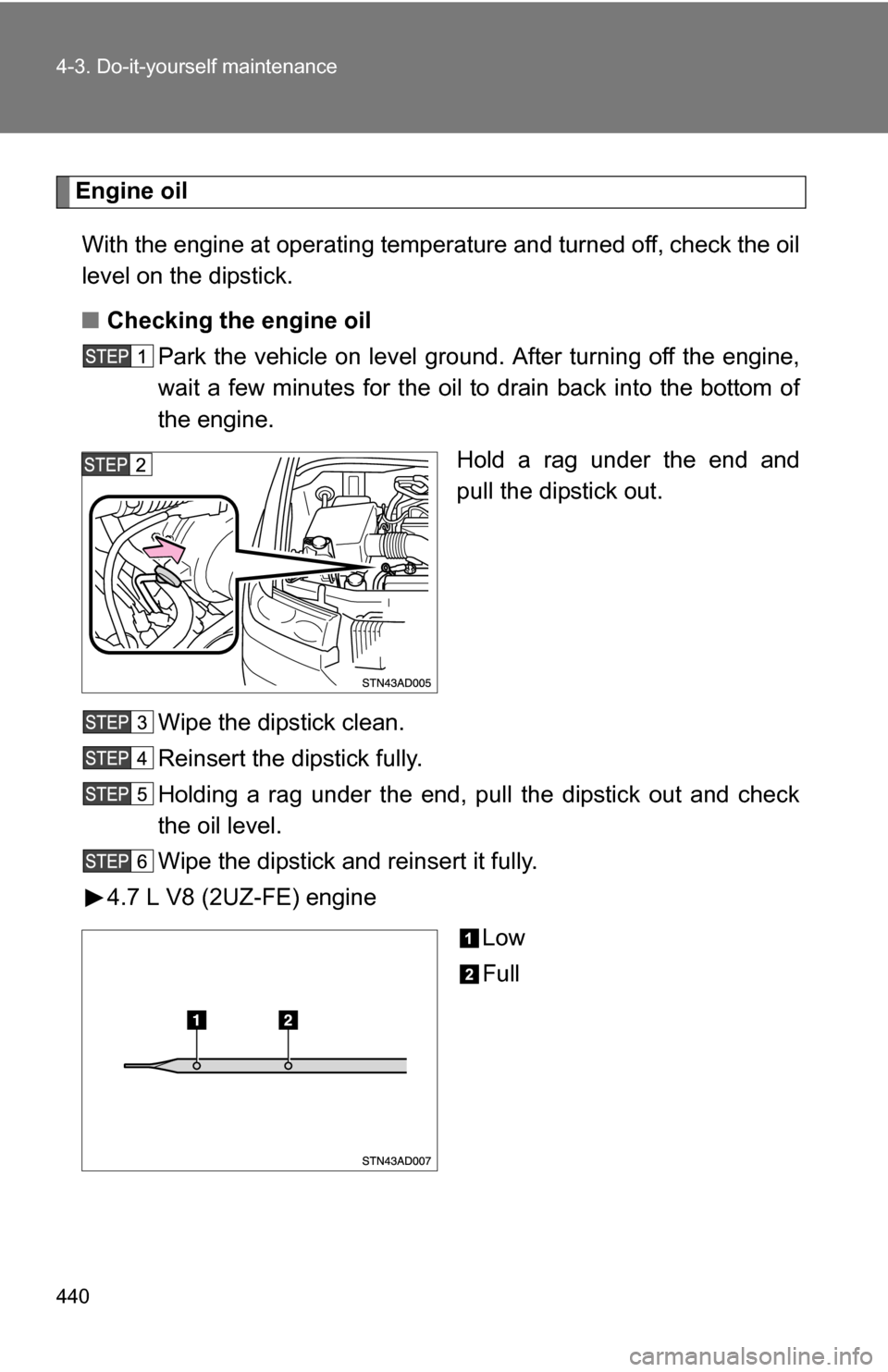
440 4-3. Do-it-yourself maintenance
Engine oilWith the engine at operating temperature and turned off, check the oil
level on the dipstick.
■ Checking the engine oil
Park the vehicle on level gro und. After turning off the engine,
wait a few minutes for the oil to drain back into the bottom of
the engine.
Hold a rag under the end and
pull the dipstick out.
Wipe the dipstick clean.
Reinsert the dipstick fully.
Holding a rag under the end, pull the dipstick out and check
the oil level.
Wipe the dipstick and reinsert it fully.
4.7 L V8 (2UZ-FE) engine
Low
Full
Page 442 of 596

442 4-3. Do-it-yourself maintenance
Remove the oil filler cap, turning it counterclockwise.
Add engine oil slowly.
Checking the dipstick.
Reinstall the filler cap, turning it clockwise.
The approximate quantity of oil needed to raise the level between low and
full on the dipstick is indicated as follows:
4.7 L V8 (2UZ-FE) engine
1.6 qt. (1.5 L, 1.3 lmp. qt.)
5.7 L V8 (3UR-FE) engine
1.2 qt. (1.1 L, 1.0 lmp. qt.)
■ Recommended viscosity
4.7 L V8 (2UZ-FE) engine
SAE 5W-30 is the best choice for
good fuel economy, and good
starting in cold weather.
*: If SAE 5W-30 oil is not avail-able, SAE 10W-30 oil may be
used. However, it should be
replaced with SAE 5W-30 at
the next oil change.
5.7 L V8 (3UR-FE) engine
SAE 5W-20 or 0W-20
*: SAE 5W-20 or 0W-20 engineoil may be used. However,
SAE 0W-20 is the best choice
for good fuel economy and
good starting in cold weather.
Outside temperature
Outside temperature
Page 547 of 596

547
6-1. Specifications
6
Vehicle specifications
Lubrication system
4.7 L V8 (2UZ-FE) engine
*: 5W-30 is an oil that provides
optimal levels of fuel efficiency.
Oil viscosity
● The 5W portion of the oil viscosity rating indicates the characteristic
of the oil which allows cold startab ility. Oils with a lower value before
the W allow for easier starting of the engine in cold weather.
● The 30 in 5W-30 indicates the oil viscosity when the oil is at its
operating temperature. An oil with a higher viscosity may be better
suited if the vehicle is operated at high speeds, or under extreme
load condition.
Oil capacity
drain and refill
(Reference) With filter
Without filter 6.6 qt. (6.2 L, 5.5 Imp.qt.)
6.0 qt. (5.7 L, 5.0 Imp.qt.)
Oil grade
ILSAC multigrade engine oil
Recommended oil
viscosity Use Toyota approved “Toyota Genuine Motor
Oil” or equivalent to satisfy the grade and
viscosity shown below.
Outside temperature
Page 548 of 596
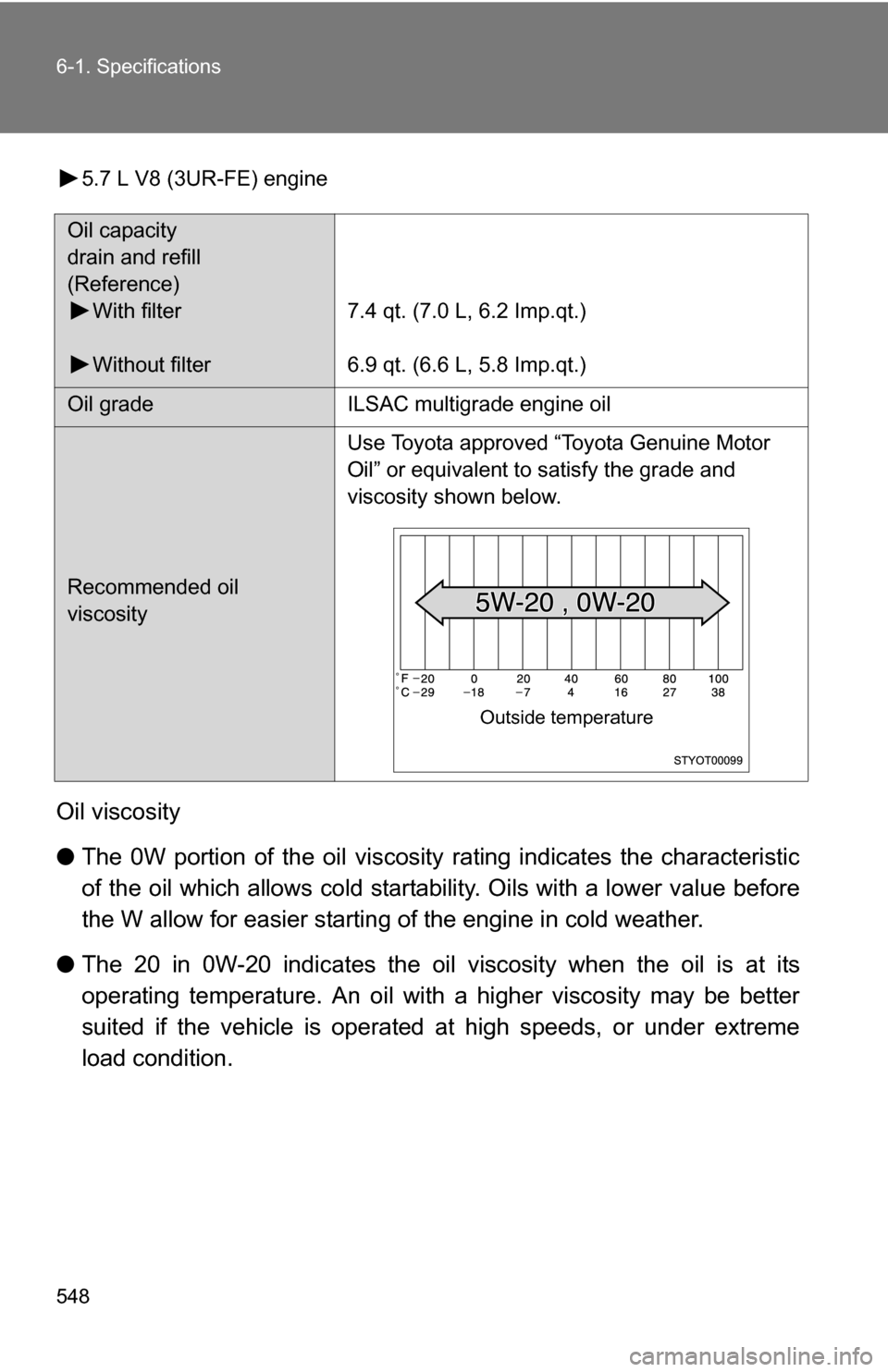
548 6-1. Specifications
5.7 L V8 (3UR-FE) engine
Oil viscosity
●The 0W portion of the oil viscosity rating indicates the characteristic
of the oil which allows cold startab ility. Oils with a lower value before
the W allow for easier starting of the engine in cold weather.
● The 20 in 0W-20 indicates the oil viscosity when the oil is at its
operating temperature. An oil with a higher viscosity may be better
suited if the vehicle is operated at high speeds, or under extreme
load condition.
Oil capacity
drain and refill
(Reference)
With filter
Without filter 7.4 qt. (7.0 L, 6.2 Imp.qt.)
6.9 qt. (6.6 L, 5.8 Imp.qt.)
Oil grade
ILSAC multigrade engine oil
Recommended oil
viscosity Use Toyota approved “Toyota Genuine Motor
Oil” or equivalent to satisfy the grade and
viscosity shown below.
Outside temperature
Page 563 of 596

563
6-1. Specifications
6
Vehicle specifications
Warning: The temperature grades for this tire are established for a
tire that is properly inflated and not overloaded.
Excessive speed, underinflation,
or excessive loading, either
separately or in combination, can cause heat buildup and possible
tire failure.
Glossary of tire terminology
Tire related termMeaning
Cold tire inflation
pressure
Tire pressure when the vehicle has been
parked for three hours or more, or has not
been driven more than 1 mile or 1.5 km under
that condition
Maximum inflation
pressureThe maximum cold inflated pressure to which a
tire may be inflated, s hown on the sidewall of
the tire
Recommended
inflation pressureCold tire inflation pressure recommended by a
manufacturer
Accessory weight
The combined weight (in excess of those
standard items which may be replaced) of
transmission, power steering, power brakes,
power windows, power seats, radio and heater,
to the extent that these items are available as
factory-installed equipment (whether installed
or not)
Curb weight
The weight of a motor vehicle with standard
equipment, including the maximum capacity of
fuel, oil and coolant, and if so equipped, air
conditioning and additional weight optional
engine
Maximum loaded
vehicle weight
The sum of:
(a) Curb weight
(b) Accessory weight
(c) Vehicle capacity weight
(d) Production options weight
Page 586 of 596
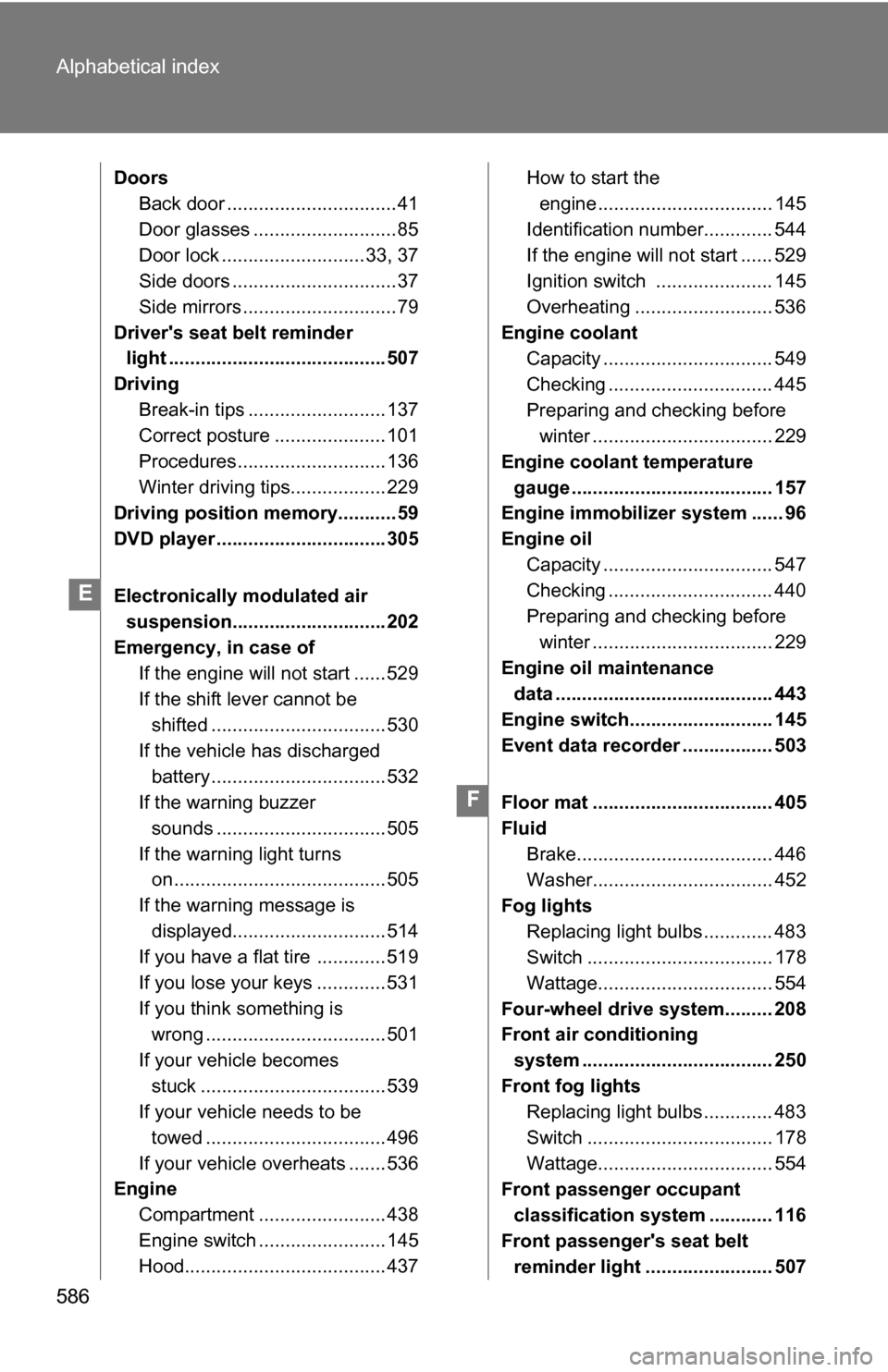
586 Alphabetical index
DoorsBack door ................................41
Door glasses ...........................85
Door lock ...........................33, 37
Side doors ...............................37
Side mirrors .............................79
Driver's seat belt reminder light ......................................... 507
Driving Break-in tips .......................... 137
Correct posture ..................... 101
Procedures ............................ 136
Winter driving tips.................. 229
Driving position memory...........59
DVD player ................................ 305
Electronically modulated air
suspension............................. 202
Emergency, in case of
If the engine will not start ...... 529
If the shift lever cannot be shifted ................................. 530
If the vehicle has discharged battery ................................. 532
If the warning buzzer
sounds ................................ 505
If the warning light turns on ........................................ 505
If the warning message is displayed............................. 514
If you have a flat tire ............. 519
If you lose your keys ............. 531
If you think something is wrong .................................. 501
If your vehicle becomes stuck ................................... 539
If your vehicle needs to be
towed .................................. 496
If your vehicle overheats ....... 536
Engine
Compartment ........................ 438
Engine switch ........................ 145
Hood...................................... 437 How to start the
engine ................................. 145
Identification number............. 544
If the engine will not start ...... 529
Ignition switch ...................... 145
Overheating .......................... 536
Engine coolant Capacity ................................ 549
Checking ............................... 445
Preparing and checking before winter .................................. 229
Engine coolan t temperature
gauge ...................................... 157
Engine immobilizer system ...... 96
Engine oil
Capacity ................................ 547
Checking ............................... 440
Preparing and checking before winter .................................. 229
Engine oil maintenance
data ......................................... 443
Engine switch........................... 145
Event data recorder ................. 503
Floor mat .................................. 405
Fluid Brake..................................... 446
Washer.................................. 452
Fog lights Replacing light bulbs ............. 483
Switch ................................... 178
Wattage................................. 554
Four-wheel drive system......... 208
Front air conditioning system .................................... 250
Front fog lights Replacing light bulbs ............. 483
Switch ................................... 178
Wattage................................. 554
Front passenger occupant
classification system ............ 116
Front passenger's seat belt reminder light ........................ 507
E
F